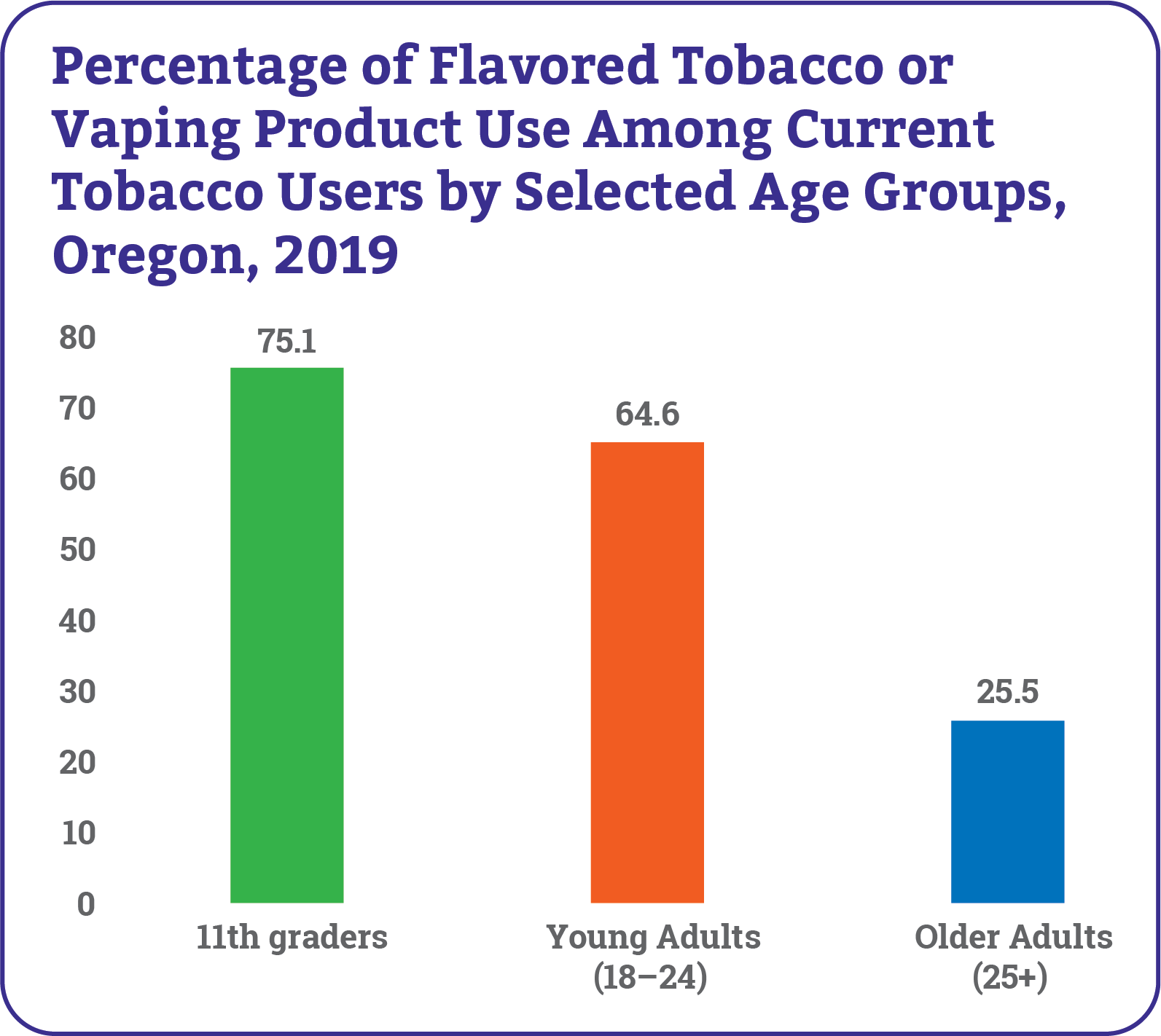Flavored nicotine use among youth is an epidemic across the country, state and regionally. In Clackamas County, the problem is even more pronounced, prompting Clackamas Public Health to issue a Health Advisory.
Fortunately, there are proven strategies and community support for solutions that protect youth from the harms of tobacco and vaping products.
Health Impacts: Vaping is NOT Harmless
E-cigarettes contain extremely high levels of nicotine:
- One JUUL pod can contain as much nicotine as a pack of cigarettes.
Flavors that appeal to children and teens, such as cotton candy, are added to e-cigarettes and other nicotine products to soften the harsh taste and entice new users.
- E-cigarettes share many of the same dangers as traditional cigarettes since they contain numerous known toxins, including nicotine.
- Nicotine is highly addictive and can cause serious harm in young people, impacting learning, memory, and attention.
- Evidence shows youth e-cigarette use leads to future use of conventional tobacco products.
Rates of Youth Nicotine Use
Teens overwhelmingly use e-cigarettes over conventional cigarettes, thanks to the tobacco industry’s successful marketing of flavored products. While teen use of conventional cigarettes has fallen dramatically over decades, use of e-cigarettes has skyrocketed to nearly 30% among teens.
The Portland metro region is experiencing the same epidemic of flavored nicotine use, and the problem is even more pronounced in Clackamas County. When compared to their peers across Oregon, the use of tobacco and e-cigarette products for Clackamas County 11th graders is the highest in the region.

In Oregon, 75% of 11th graders who use tobacco products report that they use flavored products. Compare that with just 25% of adults over the age of 25 and it becomes clear that flavored tobacco has a clear target demographic
Rising Rates and Inequities
Brain development continues into the mid-20s, so it is especially harmful for the tobacco industry to market colorful packaging and sweet flavors to young people. However, tobacco companies have a long history of using predatory marketing tactics to attract young people and often deliberately target specific communities. As a result, massive inequities for nicotine product use exist across different communities, most impacting youth of color, LGBTQ youth and low-income households.
Reducing Access: Proven Strategies
Ban the sale of flavored products
- There are over 300 jurisdictions across the U.S that have imposed flavor bans.
- Flavor bans in Massachusetts significantly decreased youth nicotine use, particularly when neighboring jurisdictions also banned the sale of flavored products.
- Washington County residents overwhelmingly voted (77%) in May 2022 to approve a local flavor ban. This suggests strong public support to protect children from nicotine products and opens the door for other counties or the state to follow suit.
Remove nicotine from school zones
- Studies consistently show that youth are more likely to smoke when they live or go to school in neighborhoods with a high density of tobacco retailers.
- Over half of public schools have a tobacco retailer within a ten-minute walk from campus.
- In Clackamas County, there are 136 nicotine retailers within a ten-minute walk from a public school.
Price promotion regulation
- The price of nicotine products has a direct and significant effect on usage. In 2018, nicotine industry spent 85%, or $7.2 billion of its total budget, on price promotions.
- Youth are more sensitive to nicotine price increases than adults. For every 10% cigarettes price increase, youth use is reduced by 5%.
- Washington County’s recent flavor ban ordinance also prohibits the use of coupons or price promotions for any tobacco or nicotine product, making them less accessible to youth.
Call to Action: Protecting Our Youth
Policy change and regional collaboration can meaningfully reduce access and use of nicotine products. Clackamas County Public Health, working closely with community and regional public health partners, is committed to taking action to protect youth from the harms of nicotine use. Join us!
Resources and More Information
The Oregon Tobacco Quit Line helps you create a quit plan to get ready, take action and live tobacco-free. Quit Coaches, many of whom are former smokers, never pressure you to quit before you're ready.
- English: 1-800-QUIT-NOW (1-800-784-8669) or QUIT NOW
- Español: 1-855-DEJELO-YA (1-855.-35356-92) or DEJARLO AHORA
- TTY 1-877-777-6534
Learn about the “Don’t Lean on Nicotine” campaign and join the local effort to help local youth quit vaping:
- For help quitting, text GO VAPELESS to 88709
- Help spread the word by visiting the “Don’t Lean on Nicotine” website.
 Translate
Translate







.png)
